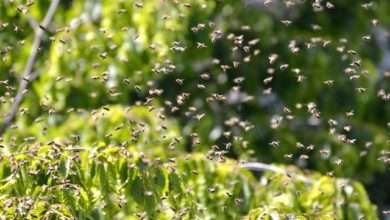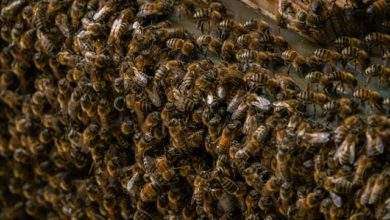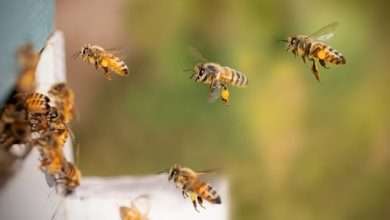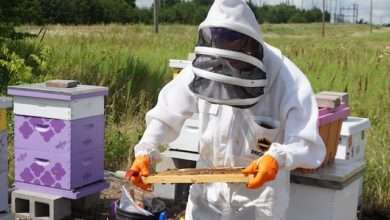Small Hive Beetles – How Many is too Much?
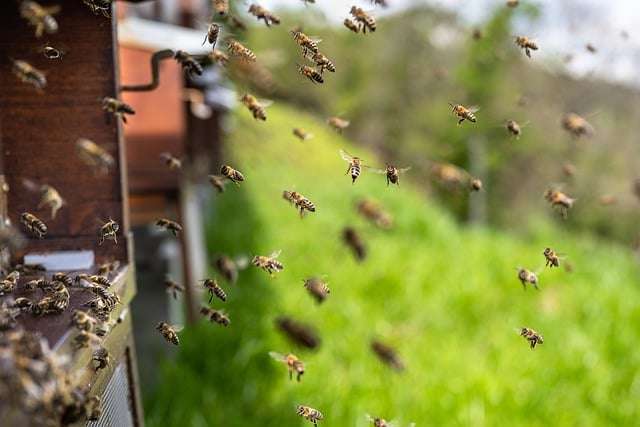
Small Hive Beetles (Aethina tumida) are a notorious threat to honeybee colonies around the world. These small but destructive pests can wreak havoc on beehives, causing significant damage to honeycomb and bee larvae, and ultimately leading to the collapse of entire colonies.
Understanding the lifecycle, factors affecting population, signs of infestation, and methods of control is crucial for beekeepers to protect their hives and the precious pollinators within.
Definition of Small Hive Beetles
Small Hive Beetles are an invasive species native to Africa and were first discovered outside their native range in the early 1990’s, in Florida, United States. These beetles measure about 4 to 7 millimeters in length and have a dark brown to black appearance. They possess segmented elytra (the modified forewings of beetles) that allow them to fly short distances, but generally, they are poor flyers. Small Hive Beetles have a distinctive anatomical structure, including a flattened body and clubbed antennae.
Impact on Beehives
Small Hive Beetles can present a significant threat to the health and productivity of beehives. These pests primarily target weak or stressed colonies, taking advantage of their compromised defenses. Once inside a beehive, the beetles lay their eggs in crevices or cracks, such as inside honeycomb cells or around the hive’s edges. The beetles’ larvae feed on bee larvae, pollen, honey, and wax, causing extensive damage and leading to the fermentation and spoiling of honey. The larvae eventually pupate, and adult beetles emerge to continue the destructive cycle.
The presence of Small Hive Beetles in beehives can cause a variety of detrimental effects. The stress caused by the beetles’ presence and their burrowing activities can lead to aggressive behavior in bees, ultimately resulting in weakened hives and reduced honey production.
Additionally, beetles introduce yeast and bacteria into the hive, accelerating honey fermentation and spoilage. This contamination renders the honey unsellable and compromises the overall quality and taste.
Importance of Controlling Beetle Populations
Controlling Small Hive Beetle populations is of utmost importance for the well-being of honeybees and the sustainability of beekeeping practices. Failure to address beetle infestations can lead to severe consequences, including the loss of entire colonies.
By actively managing and controlling beetle populations, beekeepers can protect their hives from this destructive pest. Various methods can be employed to control the beetles, including the use of beetle traps, keeping strong and healthy colonies, maintaining proper hive hygiene, and utilizing chemical treatments when necessary. Timely intervention and implementing prevention strategies are crucial in minimizing the impact of Small Hive Beetles on bee colonies.
The control of Small Hive Beetle populations not only ensures the survival and productivity of bees but also promotes the pollination services they provide. Bees play a vital role in pollinating crops and wildflowers, contributing to food security and ecosystem health. By safeguarding bee populations from the threats posed by Small Hive Beetles, we can protect the delicate balance of our ecosystems and preserve the vital role that bees play in our world.
Small Hive Beetle Lifecycle
Here are details of the small hive beetle lifecycle, shedding light on its various stages and reproductive capabilities.
- Egg Stage: The small hive beetle lifecycle begins with the egg stage. After mating, the female beetle lays her small, oval-shaped eggs inside crevices near honeycomb cells or on any available hive surface. These eggs are usually white and barely visible to the naked eye, making detection challenging for beekeepers.
- Larval Stage: Upon hatching, the small hive beetle larvae emerge from their eggs, ready to wreak havoc on the honey bee colony. These legless grubs are creamy white in color with a curved body shape, resembling small maggots. They possess special mouthparts that allow them to devour honey, pollen, wax, and even brood. During this stage, the small hive beetle larvae grow rapidly by consuming bee colony resources. They can move freely throughout the hive, gorging themselves on honeycombs and causing extensive damage to the brood. The presence of larvae triggers the bees’ defensive response, leading to the formation of “sliming” behavior where they attempt to encapsulate the larvae with propolis.
- Pupal Stage: As the small hive beetle larvae near the end of their larval stage, they seek out secluded locations within the hive to pupate. Pupation is a crucial stage where the larvae transform into adults. The larvae build small, dark-colored, earthen cells in which they undergo metamorphosis, eventually emerging as adult beetles.
- Adult Stage: Upon emerging from their pupal cells, the small hive beetle reaches its adult stage. Adult beetles are characterized by a hard exoskeleton with an oval body shape, measuring approximately 5 to 7 millimeters in length. They have dark brown or black coloring and are equipped with antennae and spiky legs. Adult beetles actively seek out food sources within the hive, targetting honey, pollen, and brood. They possess a unique behavioral adaptation: when disturbed, these pests will burrow themselves into combs and produce an offensive odor, causing the bees to abandon their hive. Adult beetles can survive outside the hive for up to eight weeks, allowing them to infest new colonies and perpetuate their destructive activities.
- Reproduction Rate: The small hive beetle demonstrates a remarkably high reproductive rate. A single female beetle can lay hundreds, if not thousands, of eggs throughout her lifespan. Under favorable conditions, this rate can accelerate even further. Rapid reproduction allows the small hive beetle population to grow exponentially, quickly overwhelming the honey bee colony’s ability to defend against their infestation.
Understanding the various stages of the small hive beetle lifecycle is essential for implementing effective management strategies in beekeeping operations. By recognizing the characteristics and behaviors of each stage, beekeepers can identify infestations early, protecting their honey bee colonies from the devastating consequences of small hive beetle infestations. Vigilance and proactive management will be the key to maintaining healthy and thriving bee colonies in the face of this formidable pest.
Factors Affecting Small Hive Beetle Population
Here are the various factors that can affect small hive beetle populations, including climate and weather, colony strength, hive management practices, beekeeper interventions, and food availability.
Climate and Weather:
- Small hive beetles thrive in warm and humid climates, making them more prevalent in regions with such conditions.
- High humidity levels increase small hive beetle reproduction rates, as they require moist conditions for their larvae to develop.
- Heavy rainfall and prolonged periods of moisture can create a favorable environment for small hive beetle populations to flourish.
Colony Strength:
- Strong and healthy honeybee colonies are better equipped to withstand small hive beetle infestations.
- In weak or struggling colonies, bees may be unable to effectively defend the hive or remove and contain the beetles, allowing the population to grow uncontrollably.
- Maintaining strong colonies through proper nutrition, disease management, and queen quality can help minimize the impact of small hive beetles.
Hive Management:
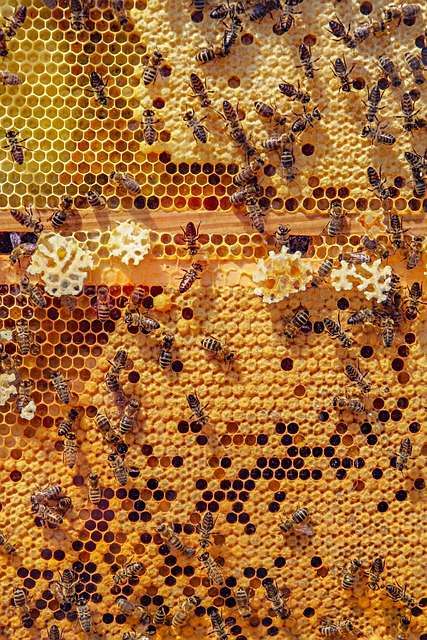
- Proper hive management techniques play a crucial role in controlling small hive beetle populations.
- Regular hive inspections allow beekeepers to identify and address beetle infestations at an early stage.
- Maintaining a clean and well-maintained hive, including removing or repairing damaged frames, reduces small hive beetle hiding places and limits their population growth.
- Implementing beetle traps, such as oil traps or diatomaceous earth, can help capture and control small hive beetles.
Beekeeper Interventions:
- Beekeepers can take proactive measures to limit small hive beetle populations.
- Introducing beetle-destroying organisms, such as the small hive beetle nematode (Heterorhabditis indica), can help reduce beetle numbers in infested hives.
- The use of screen bottom boards, which prevent beetles from re-entering the hive after being expelled by bees, can aid in managing small hive beetle populations.
- Regularly removing and destroying any beetle-infested debris near hives can reduce the likelihood of reinfestation.
Food Availability:
- Adequate and balanced food sources for honeybees are essential in preventing small hive beetle population explosions.
- Bees require a diverse range of pollen and nectar to maintain their health and vitality.
- A lack of sufficient food can weaken colonies, making them more susceptible to small hive beetle infestations.
- Planting diverse and bee-friendly floral resources around apiaries can provide bees with ample nutrition, minimizing the impact of small hive beetles.
By understanding these factors and implementing appropriate management strategies, beekeepers can effectively control small hive beetles and maintain healthy honeybee colonies. Regular monitoring, proper hive maintenance, and providing a nutritious environment for bees will aid in reducing the impact of this troublesome pest and safeguarding the vitality of our precious pollinators.
Signs of Small Hive Beetle Infestation
Identifying the signs of small hive beetle infestations early is crucial in preventing catastrophic consequences for your honeybee colony.
- Visible Beetles in Hive: One of the most obvious signs of a small hive beetle infestation is the presence of these dark, beetle-like creatures within the hive. While small hive beetles are relatively small, measuring around 5-7 millimeters in length, their dark coloration distinguishes them from bees. Regular hive inspections are essential in detecting these pests early on.
- Slimy Residue: Small hive beetle larvae produce a slimy substance called “slime” or “sludge” when feeding on hive materials such as pollen, wax, and honey. Detecting the presence of this slimy residue in the hive is indicative of an infestation. You may notice a greasy film on the frames, cells, or the inner walls of the hive when inspecting your colony.
- Fermentation Smell: When small hive beetles feed on honey, they cause the honey to ferment, resulting in a distinct odor. If you detect an unusual, sour, or pungent smell emanating from your hive, it could be an indication of a small hive beetle infestation. This smell is often associated with the fermentation of honey, which can be due to the beetles defecating or the breakdown of hive materials.
- Discolored Combs: Small hive beetles can cause substantial damage to honeybee combs. They chew through the wax, defecate, and introduce microorganisms, leading to the discoloration of the combs. Infested combs may appear darkened or stained, exhibiting irregular patterns. Remember to inspect your frames closely for any signs of discoloration, indicating a potential small hive beetle infestation.
- Bee Agitation: Bees have a remarkable ability to sense threats to their colony, and when small hive beetles are present, the bees become agitated. If you notice an increased level of aggression or restlessness among your bees during hive inspections, it could suggest the presence of small hive beetles. Agitated bees may exhibit rapid wing movement, loud buzzing, or even attempt to sting during routine inspections.
Recognizing the signs of infestation is crucial for beekeepers to take timely action and implement appropriate management strategies to control and mitigate the damage caused by these invasive pests. By remaining vigilant and regularly inspecting your hives for visible beetles, slimy residue, fermentation smells, discolored combs, and bee agitation, you can ensure the well-being and survival of your honeybee colonies.
How Many Beetles are Safe?
- Variances in Tolerance: Different bee colonies exhibit varying levels of tolerance to small hive beetles. Some colonies may successfully control small populations of beetles, while others may experience rapid population growth and severe infestations even with a low initial beetle count.
- Monitoring Tools: Regular and vigilant inspection methods are crucial for effectively managing small hive beetles. Specialized traps are available to help monitor beetle populations, providing a quantitative measure of infestation levels.
- Thresholds: Researchers and experienced beekeepers suggest that a beetle count exceeding 10 beetles per trap, per day, indicates a concerning infestation level. However, keep in mind that the threshold for intervention may vary depending on local conditions, beekeeping goals, and the overall health of the hive.
Controlling Small Hive Beetle Populations
In the ever-evolving world of beekeeping, controlling the populations of pests such as the small hive beetle (Aethina tumida) is a crucial task. These destructive invaders can wreak havoc on honeybee colonies, causing significant damage if left unaddressed. Thankfully, a range of strategies and techniques have been developed to combat these beetles and protect our beloved bees.
- Monitoring Beetle Populations: Effective pest management necessitates continuous monitoring to stay ahead of small hive beetle infestations. Regular hive inspections are essential to identify signs of beetle presence, such as adult beetles, larvae, or the distinctive slimy residue they leave behind. Monitoring techniques may also include the use of beetle detection traps, which provide an early warning system for beekeepers to take appropriate action.
- Hive Beetle Traps: Traps are a valuable tool in the battle against small hive beetles. These devices help beekeepers capture and remove adult beetles from beehives before they can cause significant harm. Various trap designs are available, ranging from oil-based traps to beetle blaster traps that utilize a combination of oil and diatomaceous earth. By strategically placing these traps within the hive, beekeepers can effectively control small hive beetle populations in an environmentally friendly manner.
- Thermal Treatments: Thermal treatments have proven to be an effective method in controlling hive beetles. By subjecting the infested hive to controlled temperatures, usually between 102°F to 105°F (38.9°C to 40.6°C), the beetles and their larvae can be effectively eliminated, without harming the bees. Considered very labor-intensive, this treatment is best suited for hobbyist beekeepers, managing 10 colonies or less.
- Beetle-Resistant Hive Designs: Another approach to managing small hive beetle populations is to utilize hive designs that deter beetle infestations. Beekeepers have developed innovative hive designs with beetle-resistant features, such as reduced entrance sizes, screened bottom boards, or oil traps integrated into the hive structure. These modifications help create an inhospitable environment for beetles while maintaining a suitable habitat for honeybees.
- Natural Predators: Nature provides its own pest control agents, and small hive beetles are no exception. Some beneficial insects, birds, and other small animals prey upon small hive beetles, helping to keep their populations in check. Encouraging the presence of natural predators in the vicinity of beehives can provide an effective and environmentally friendly means of beetle control. Additionally, beekeepers may consider introducing certain beetle-specific predators, such as the small hive beetle larvae-predator beetle (Teretrius spp.), to help combat infestations.
- Chemical Control: As a last resort, when other strategies or techniques have proven insufficient, chemical control options can be considered. However, it is crucial to use these methods judiciously and cautiously to minimize any potential negative impacts on honeybees and the overall environment. Beekeepers must follow approved guidelines and regulations when employing chemical control measures, ensuring the safety of their colonies and honey production.
Controlling small hive beetle populations is a challenging task for beekeepers, but by adopting a comprehensive approach that combines monitoring, traps, beetle-resistant hive designs, natural predators, and judicious chemical control, it is possible to effectively manage these destructive pests. By safeguarding our honeybee colonies, we help protect these invaluable pollinators and ensure the continuation of a thriving and sustainable ecosystem.
Conclusion
Small hive beetles can have a detrimental impact on honeybee colonies if left unmanaged. Understanding the importance of monitoring, being aware of acceptable beetle thresholds, and implementing effective management strategies are key to protecting honeybee colonies from infestations.
By staying proactive and informed, beekeepers can ensure the health and productivity of their hives, promoting a thriving bee population and safeguarding honey production.

FAQ’s:
What are Small Hive Beetles?
- Small Hive Beetles (SHBs) are small, dark-colored beetles that can become a nuisance for beekeepers. They often infest beehives, feeding on pollen, honey, and bee brood, ultimately causing damage to the hive.
How do Small Hive Beetles affect bee colonies?
- When Small Hive Beetle populations become too large, they can cause significant damage to bee colonies. They lay their eggs in the hive, and the larvae feed on honey, pollen, and even young bee larvae. This can weaken the colony, leading to reduced honey production, weakened immune systems, and even colony collapse in severe cases.
How can I determine if my hive has an infestation of Small Hive Beetles?
- The presence of Small Hive Beetles can be detected through several signs. Be observant of unusual numbers of beetles inside the hive, especially around the frames. Additionally, look for dark, slimy areas on frames or the bottom board, which are characteristic smear-like traces left by the beetles.
What is considered a high population of Small Hive Beetles?
- While the threshold for an excessive Small Hive Beetle population may vary depending on factors such as hive strength and climate, it is generally recommended to take immediate action when you observe more than 5-10 beetles within a single hive.
What measures can I take to control Small Hive Beetles?
- Various methods can be utilized to manage Small Hive Beetles. Some preventive measures include reducing hive entrances to limit beetle access, implementing oil traps or beetle blasters to catch and drown the beetles, and maintaining strong and healthy colonies through regular hive inspections and good beekeeping practices.
Are Small Hive Beetles harmful to humans?
- No, Small Hive Beetles are not harmful to humans. They are primarily a concern for honeybees and the proper functioning of bee colonies.
Can Small Hive Beetles be eradicated completely?
- Complete eradication of Small Hive Beetles is challenging, but their populations can be managed effectively by implementing proactive monitoring and control measures within beekeeping operations.
How often should I inspect my hives for Small Hive Beetles?
- Regular inspections are crucial for detecting Small Hive Beetle infestation early on. We recommend conducting at least weekly checks during warmer months and increasing the frequency during peak beetle activity. However, keep in mind that local climate variations and hive conditions may influence the optimal inspection frequency.
